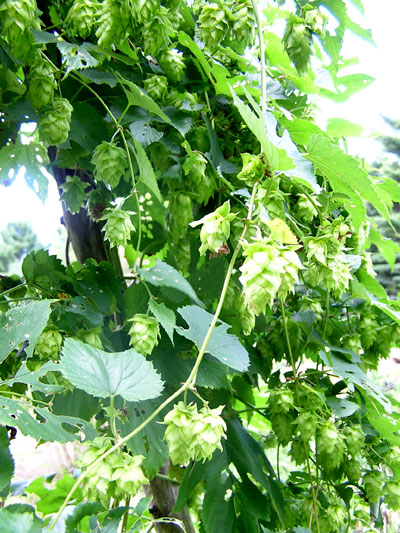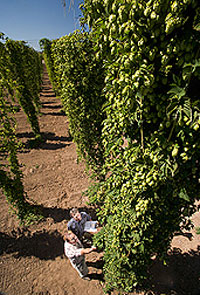 |
| “Hops” usually refers to the female flowers of hop vines, shown here growing at Merryspring Nature Center in Camden, Maine. Researchers at USDA Agricultural Research Service in Oregon have developed a new variety called ‘Teamaker’ that is especially good for making herbal tea. English photo. |
Drinking impure water was once a common way to pick up diseases, so for centuries beer was a popular alternative beverage in many nations. Harmful microorganisms were removed during its production, thanks to boiling and the addition of hops, which have natural antibiotic properties.
Hops are still an important crop. Most of the 55 to 60 million pounds of hops grown on U.S. soil each year are still used in beer, but because of their antimicrobial benefits, they are also used in products such as processed sugar and animal feed. Recent research has developed new hops for diverse uses.
Bitter and Better
Hops are an essential beer ingredient because they contain two types of bittering acids: alpha and beta. Bitter alpha acids complement the malty sweetness of beer to give the beverage its distinct flavor. They also promote the yeast-brewing process and hinder bacterial growth. Beta acids, which have a greater effect on inhibiting microbial growth, also influence bitterness but to a much lesser extent than alpha acids.
Scientists with the USDA Agricultural Research Service (ARS) are working with brewers and growers to breed new varieties of hops to improve their current uses and expand into new markets. Over the past few decades, they have developed and released several cultivars with traits such as disease resistance, climate tolerance, aesthetic appeal and high concentrations of alpha and beta acids.
Different alpha-to-beta ratios affect the physical characteristics of hops and their uses. While alpha acids are essential for brewing, their acrid flavor limits their use in other products. Low-alpha cultivars have many of the same beneficial qualities, but more diverse uses, as in herbal teas or as nutritious feed supplements.
Hops have been used in folk remedies for everything from coughs to cancer, and ‘Teamaker,’ released in 2006 by the ARS Forage Seed and Cereal Research Unit (FSCRU) at Corvallis, Oregon, is a good candidate for herbal teas. ‘Teamaker’ has the lowest alpha acid content (0.6 to 1.8%) of any commercially available hop variety, and its beta acid levels (5.4 to 13.2%) are significantly higher than those in most varieties.
This extremely high beta-to-alpha ratio gives ‘Teamaker’ all the health benefits of traditional hops cultivars without their characteristic bitterness. This creates opportunities for nontraditional uses besides tea – as in sugar processing, where beta acids from hops can substitute for an antibacterial called “formalin” (formaldehyde in water).
Another potential use is in livestock production, where animals can benefit from the antimicrobial properties of hops. The more palatable, low-alpha varieties could be mixed into animal feed to reduce microbial and fungal illnesses. In fact, researchers elsewhere have found positive effects of using hops in poultry feed as an alternative to antibiotics.
Though antibiotics have many benefits for agricultural production, such as increased efficiency and disease management, the potential for humans to develop resistance to them through food has raised public concerns. Laws have limited or banned some antibiotics in agricultural production, creating a need for a replacement. Hops may be part of the answer.
Geneticist John Henning of FSCRU told The MOF&G that “‘Teamaker,’ like almost all other hop cultivars, will survive and grow in Maine.” Commercial supplies of ‘Teamaker’ rhizomes are quite limited now, but Henning is getting some out to companies that distribute as a business, and he notes that the USDA will distribute up to five rhizomes for research purposes if requested (at www.ars.usda.gov/main/site_main.htm?modecode=53581500). For names of Oregon growers who might supply rhizomes, he suggests contacting Oregon Hop Commission Administrator Michelle Palacios at [email protected] (although rhizomes may not be available this year).
 |
| At the hop breeding facility in Corvallis, Oregon, ARS geneticist John Henning (foreground) and Oregon State University research associate Shaun Townsend evaluate hop plants for lupulin glands, which produce beta acids that influence the aroma of hops. |
Lower Trellises for Higher Profits
The FSCRU breeding program also says that producers may save up to 30% in labor costs by growing hops on low trellises – about 10 feet high, instead of the more common 18-foot trellises now used in commercial production. Lower trellises eliminate the need for “stringing” (looping strings between the hop plants and the trellis) and “training” (wiring the strongest shoots of each hop plant to the trellis to encourage the hop vines to grow in clockwise spirals). Lower-growing plants can also have reduced pest control costs.
“This could have significant cost savings,” Henning says. “Even with a slight yield reduction, you could turn a profit.” Henning and his colleagues are working to identify the gene or genes responsible for shorter growth to aid in selecting hop varieties that respond well to low-trellis production.
As part of the National Plant Germplasm System, the National Clonal Germplasm Repository (NCGR) at Corvallis maintains a hops collection that includes over 150 cultivars collected from more than 24 countries – from the Yugoslavian Ahil to the Czech Zlatan.
John A. Henning is in the USDA-ARS Forage Seed and Cereal Research Unit, 3450 S.W. Campus Way, Corvallis, OR 97331; phone (541) 738-4145, fax (541) 738-4160, [email protected]
Source: “HOPS: New Markets, Better Storage,” by Laura McGinnis, Agricultural Research, Jan. 2008; www.ars.usda.gov/is/AR/archive/jan08/hops0108.htm?pf=1
Fedco’s Advice on Growing Hops in Maine
Fedco Trees (fedcoseeds.com/trees) offers rhizomes of female plants of two cultivars of hops (Humulus lupulus) – ‘Cascade’ and ‘Willamette’ – that are hardy to zone 3. Fedco suggests growing these beautiful, twining vines on trellises or archways. They grow best in full sun and in light, rich soils with a pH of 6.5-8 but tolerate shade and most well-drained soils.
“Plant it where you want it because you may never get rid of it,” says the Fedco catalog. In early spring, dig holes about 1 foot deep and at least 3 feet apart and amend them with about 10 inches of manure, compost and other slow-release organic fertilizers. Then set two rhizomes in each hole, horizontally with the buds pointed up. Cover the rhizomes with 1 to 2 inches of loose soil until the soil is even with the surrounding ground. Water the plants frequently and lightly the first year, and mulch them.
As the main vine grows up, lateral branches extend horizontally; these produce insignificant greenish flowers followed by papery, aromatic, cone-like strobiles (the hops) on female plants. The vines may grow up to 25 feet in a single season and do best if they are trained onto strong twine 12- to 30-feet high, supported by a trellis, wire, pole, tree branch or south-facing building. When the young vines are about 1 foot long, select the two or three most vigorous vines per hill and remove the rest. Gently wrap the vines clockwise onto a string. Once trained, the vine will guide itself.
Pick the hops when they are papery but still slightly sticky and filled with yellow powder. Harvest dates vary with the variety and climate. Lower the vines to the ground in order to pick the hops safely, and then dry the hops thoroughly for a few weeks on a window screen in a dry attic. Dried hops freeze well. (Brad Hunter of Appleton, Maine, grows a lot of hops and explains that the dried product should be frozen because sunlight and oxygen degrade alpha acids in hops. “Once the hops are dry,” says Hunter, “I bag them in Seal-A-Meal bags, which are true oxygen barrier bags, unlike conventional Ziploc bags. They then go into the freezer, which keeps them dark and cold stable.” They could also be stored in the freezer in Mason jars, he adds. Some beers are bottled in brown glass, which blocks the wavelength of light that destroys alpha acids. Beers in green bottles, says Hunter, often have a “skunkiness” unless they have been commercially manipulated to minimize or offset the problem.)
Cut the vines back to the ground after they’ve been killed by frost. Each spring topdress with a hearty dose of manure and compost. To help contain the plants, prune the roots by cutting a 2- to 3-foot-wide circle with a shovel around the base of the plant each spring.
